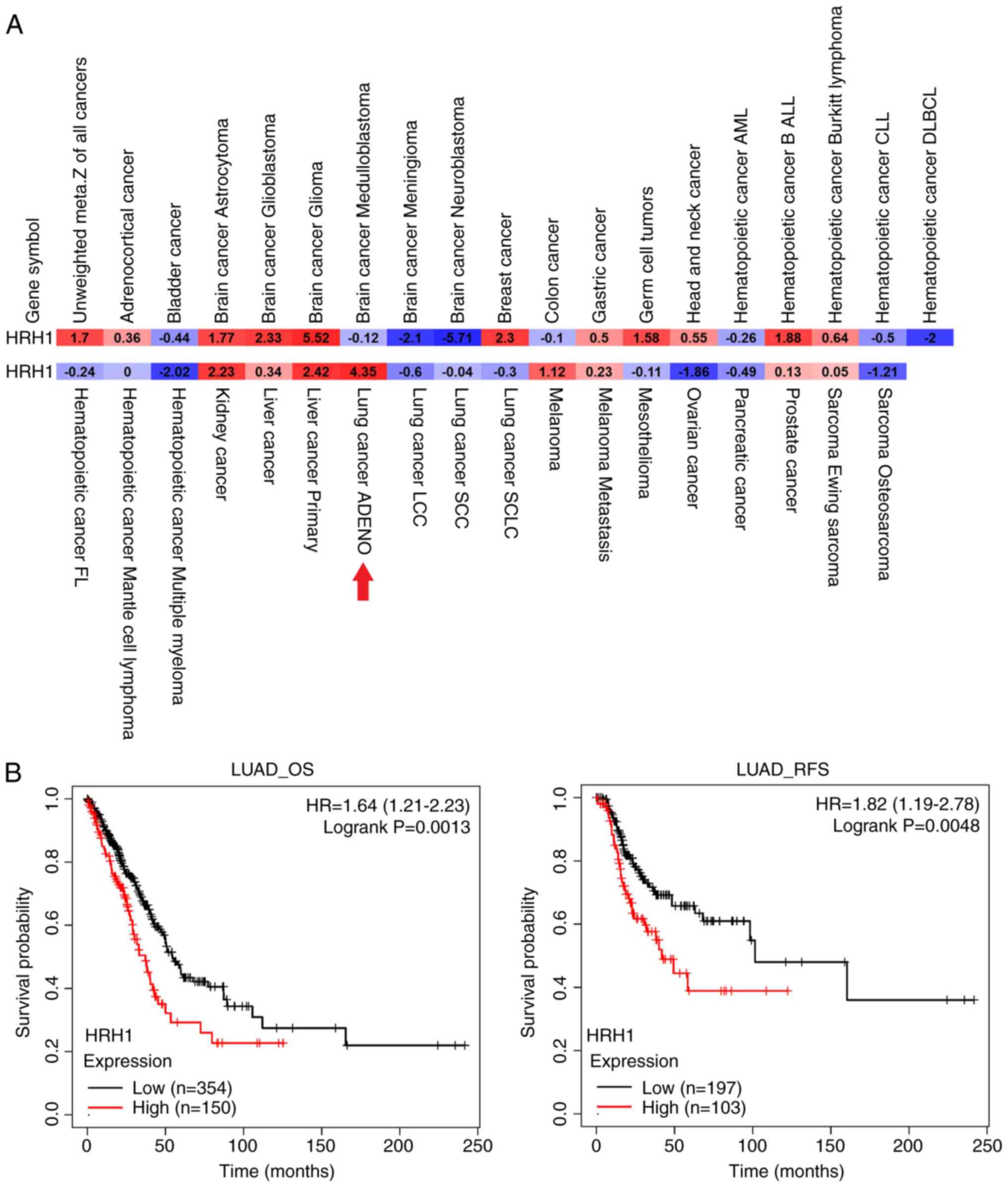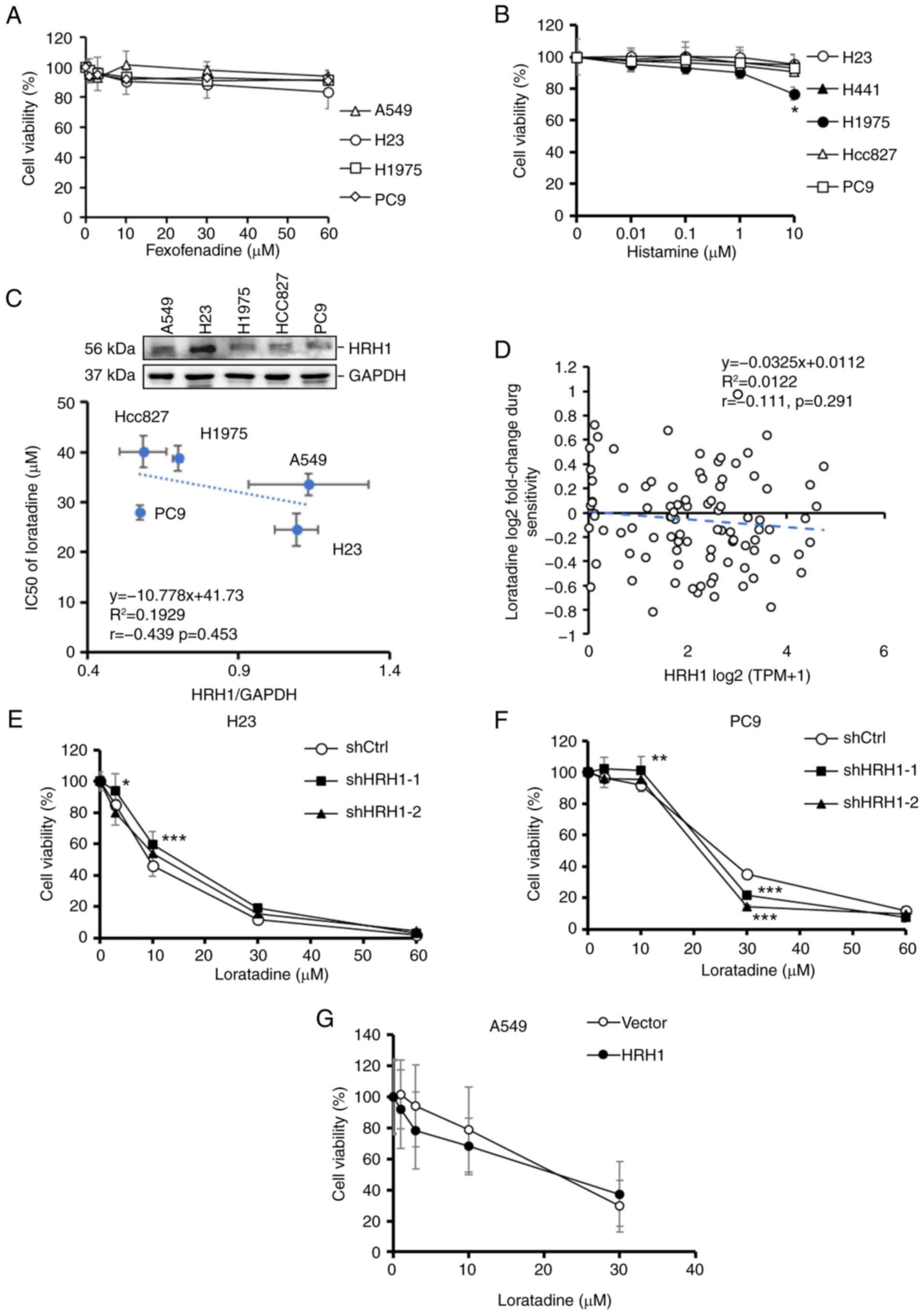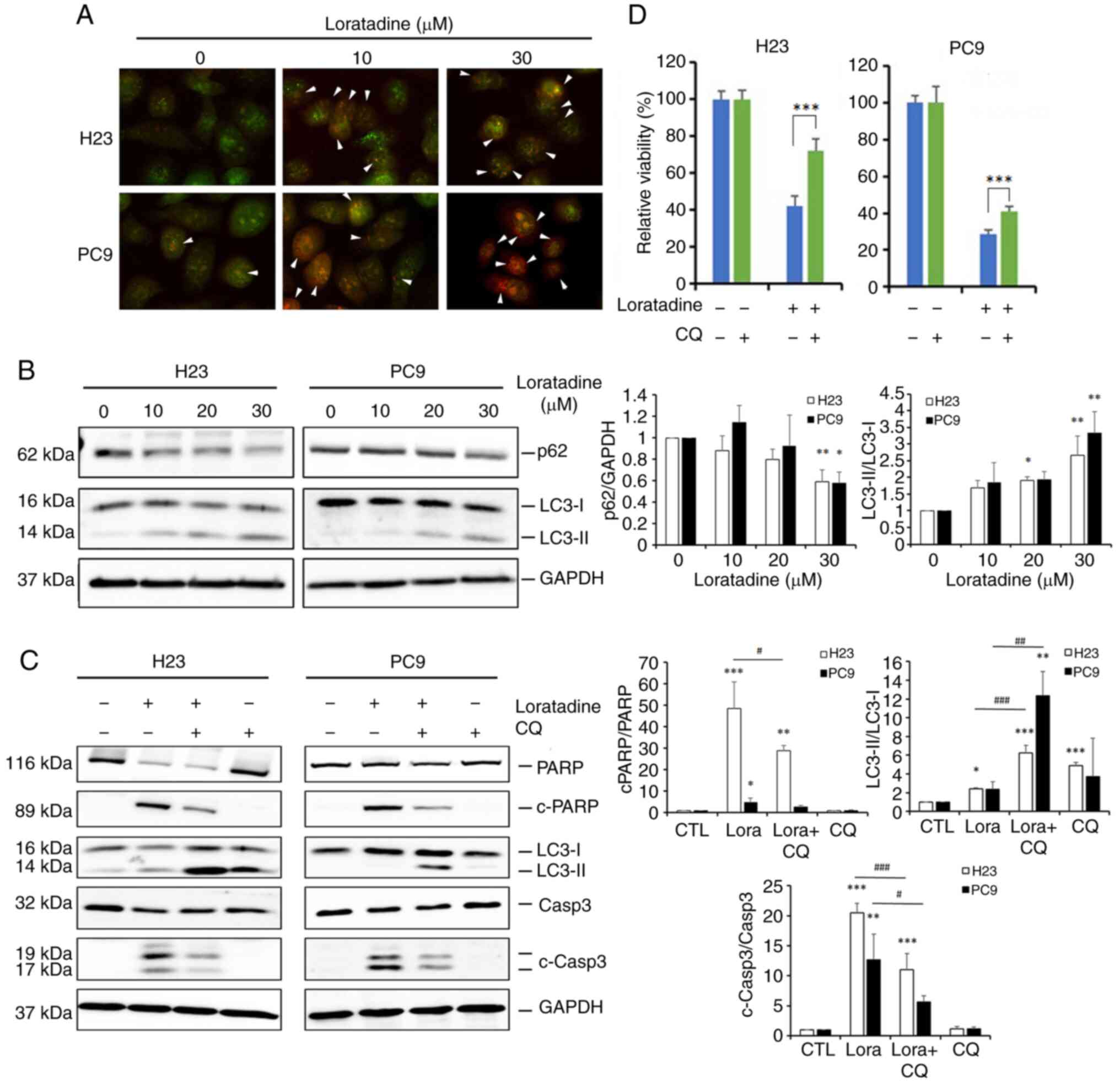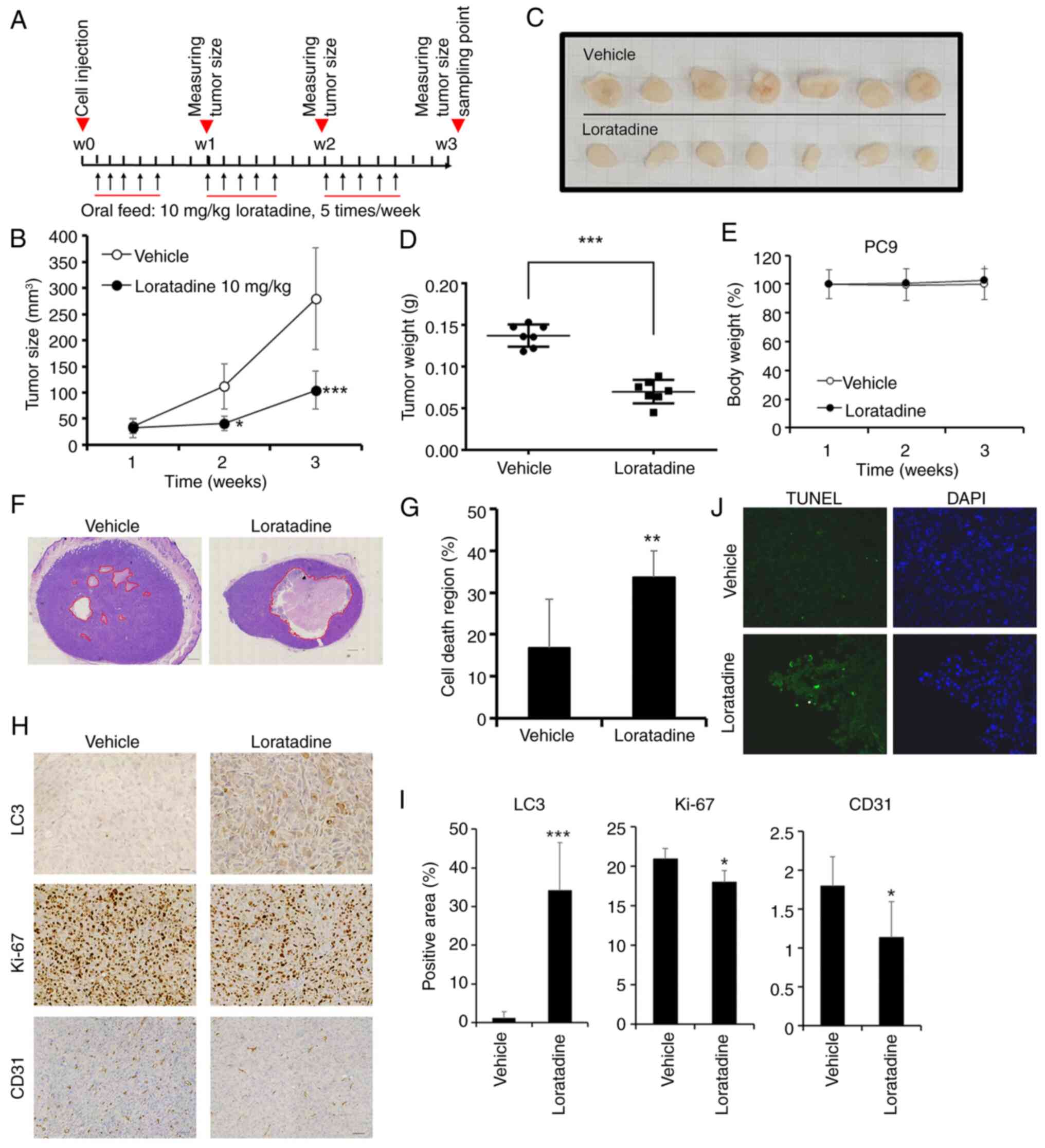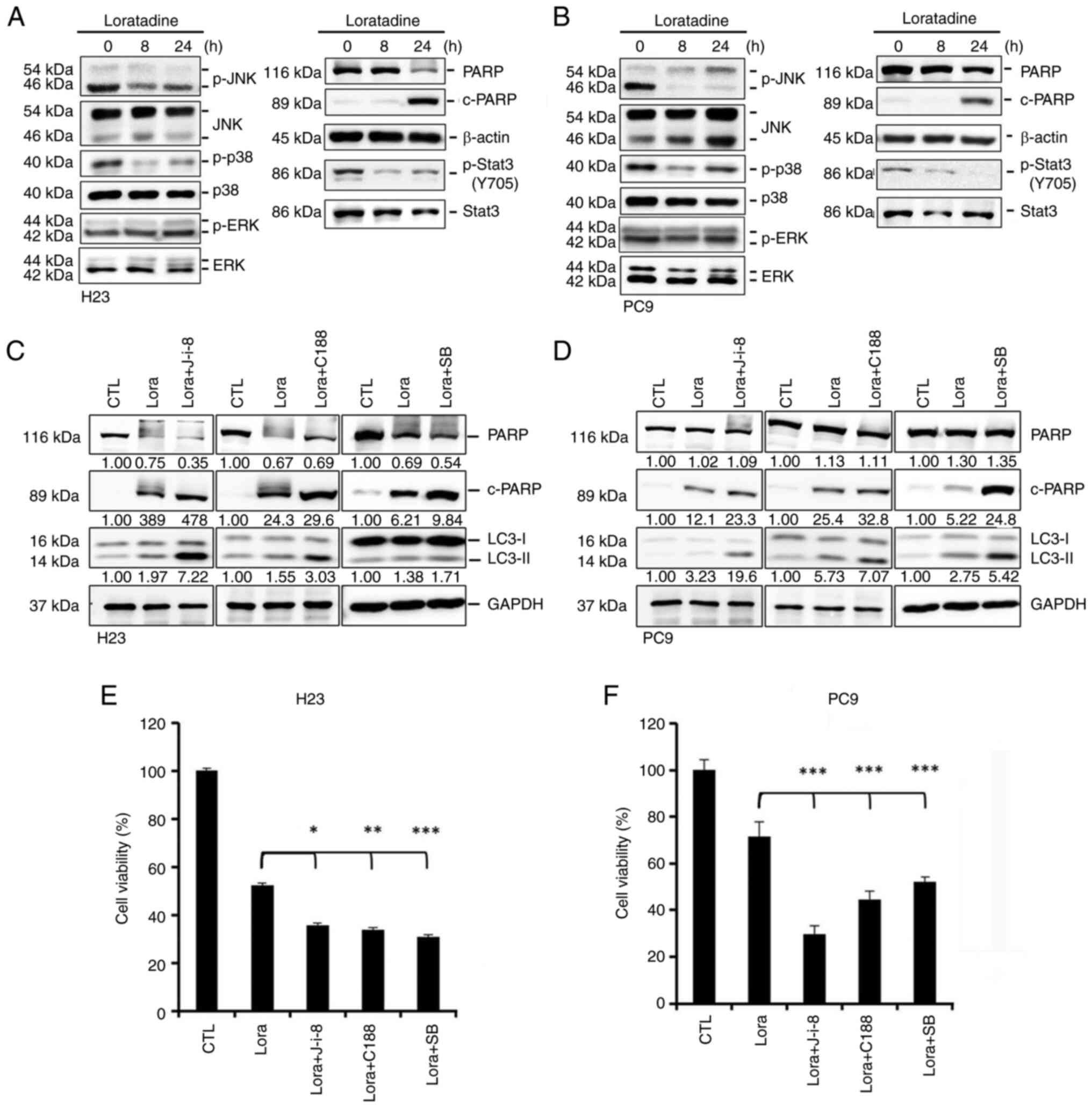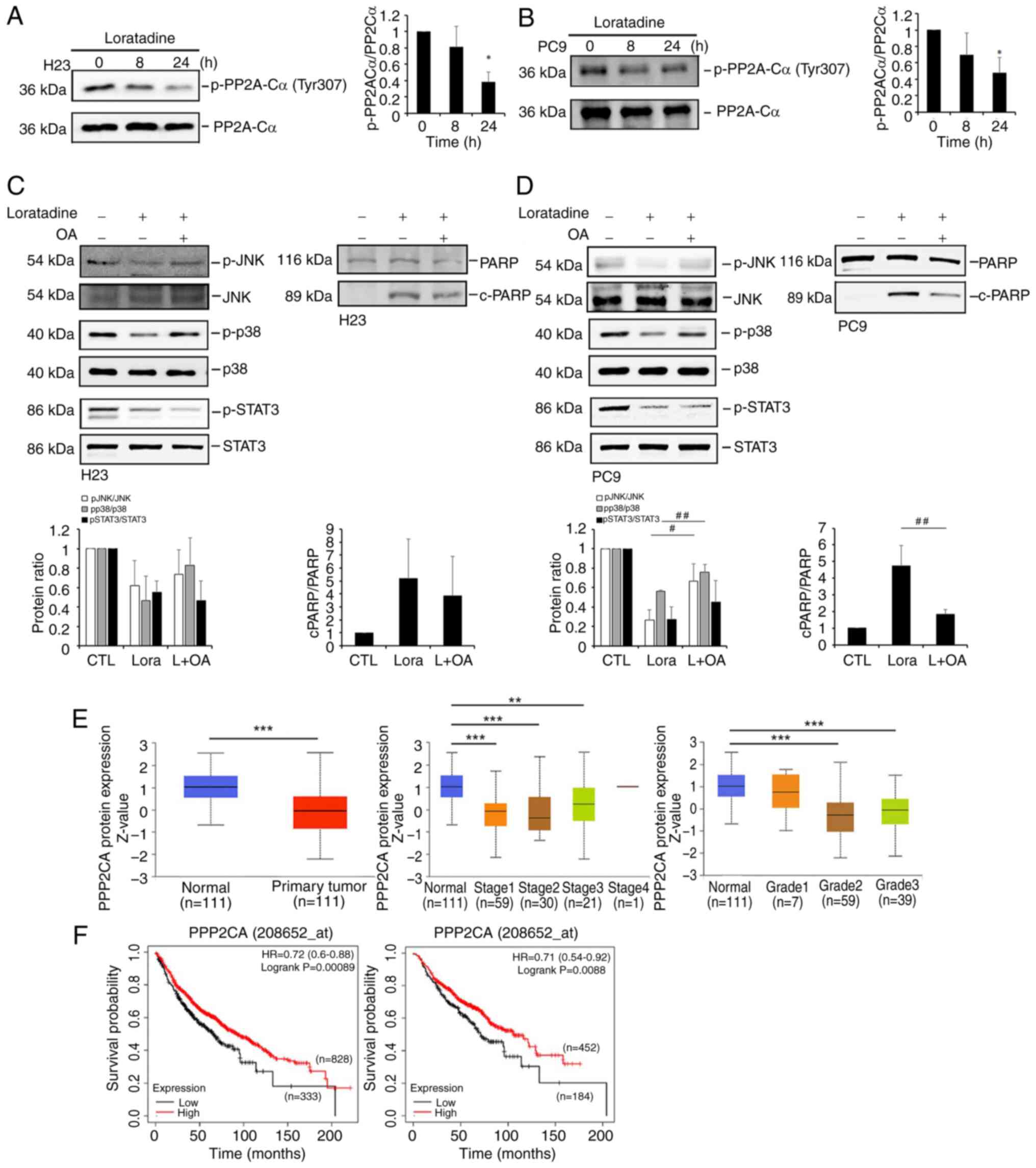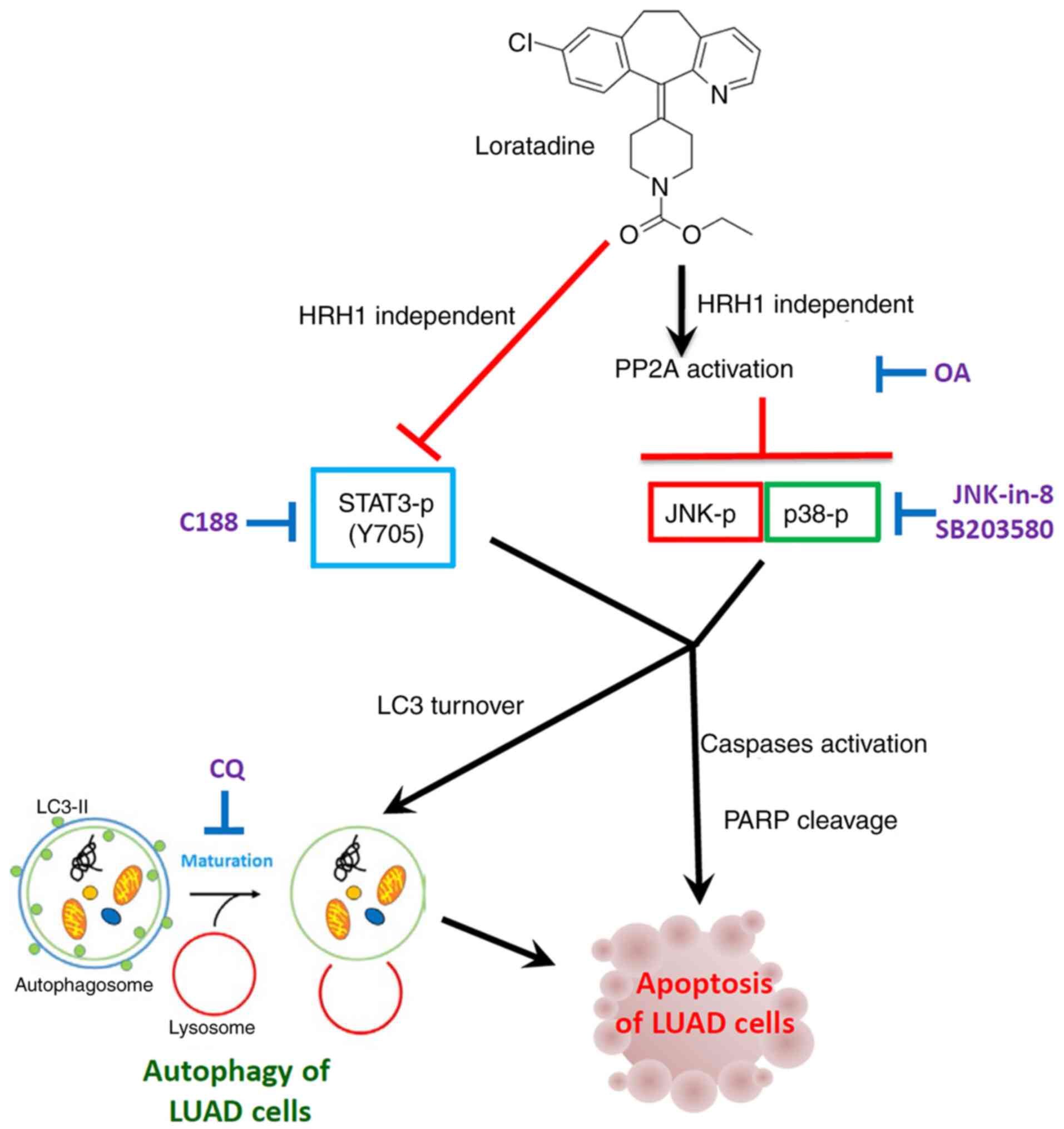|
1
|
Sung H, Ferlay J, Siegel RL, Laversanne M,
Soerjomataram I, Jemal A and Bray F: Global Cancer Statistics 2020:
GLOBOCAN Estimates of Incidence and Mortality Worldwide for 36
Cancers in 185 Countries. CA Cancer J Clin. 71:209–249. 2021.
View Article : Google Scholar : PubMed/NCBI
|
|
2
|
Dearden S, Stevens J, Wu YL and Blowers D:
Mutation incidence and coincidence in non small-cell lung cancer:
Meta-analyses by ethnicity and histology (mutMap). Ann Oncol.
24:2371–2376. 2013. View Article : Google Scholar : PubMed/NCBI
|
|
3
|
Yang SR, Schultheis AM, Yu H, Mandelker D,
Ladanyi M and Buttner R: Precision medicine in non-small cell lung
cancer: Current applications and future directions. Semin Cancer
Biol. 84:184–198. 2022. View Article : Google Scholar
|
|
4
|
Shafiei-Irannejad V, Samadi N, Salehi R,
Yousefi B and Zarghami N: New insights into antidiabetic drugs:
Possible applications in cancer treatment. Chem Biol Drug Des.
90:1056–1066. 2017. View Article : Google Scholar : PubMed/NCBI
|
|
5
|
Veschi S, De Lellis L, Florio R, Lanuti P,
Massucci A, Tinari N, De Tursi M, di Sebastiano P, Marchisio M,
Natoli C and Cama A: Effects of repurposed drug candidates
nitroxoline and nelfinavir as single agents or in combination with
erlotinib in pancreatic cancer cells. J Exp Clin Cancer Res.
37:2362018. View Article : Google Scholar : PubMed/NCBI
|
|
6
|
Baker NC, Ekins S, Williams AJ and Tropsha
A: A bibliometric review of drug repurposing. Drug Discov Today.
23:661–672. 2018. View Article : Google Scholar : PubMed/NCBI
|
|
7
|
May JR and Dolen WK: Management of
allergic rhinitis: A review for the community pharmacist. Clin
Ther. 39:2410–2419. 2017. View Article : Google Scholar : PubMed/NCBI
|
|
8
|
Fritz I, Wagner P, Bottai M, Eriksson H,
Ingvar C, Krakowski I, Nielsen K and Olsson H: Desloratadine and
loratadine use associated with improved melanoma survival. Allergy.
75:2096–2099. 2020. View Article : Google Scholar : PubMed/NCBI
|
|
9
|
Fritz I, Wagner P, Broberg P, Einefors R
and Olsson H: Desloratadine and loratadine stand out among common
H(1)-antihistamines for association with improved breast cancer
survival. Acta Oncol. 59:1103–1109. 2020. View Article : Google Scholar : PubMed/NCBI
|
|
10
|
Fritz I, Wagner P and Olsson H: Improved
survival in several cancers with use of H(1)-antihistamines
desloratadine and loratadine. Transl Oncol. 14:1010292021.
View Article : Google Scholar : PubMed/NCBI
|
|
11
|
Chen T, Hu Y, Liu B, Huang X, Li Q, Gao N,
Jin Z, Jia T, Guo D and Jin G: Combining thioridazine and
loratadine for the treatment of gastrointestinal tumor. Oncol Lett.
14:4573–4580. 2017. View Article : Google Scholar : PubMed/NCBI
|
|
12
|
Ma J, Qi J, Li S, Zhang C, Wang H, Shao L,
Yuan X and Sha Q: Desloratadine, a novel antigrowth reagent for
bladder cancer. Technol Cancer Res Treat. 19:15330338209265912020.
View Article : Google Scholar : PubMed/NCBI
|
|
13
|
Nicolau-Galmés F, Asumendi A,
Alonso-Tejerina E, Pérez-Yarza G, Jangi SM, Gardeazabal J,
Arroyo-Berdugo Y, Careaga JM, Díaz-Ramón JL, Apraiz A and Boyano
MD: Terfenadine induces apoptosis and autophagy in melanoma cells
through ROS-dependent and -independent mechanisms. Apoptosis.
16:1253–1267. 2011. View Article : Google Scholar : PubMed/NCBI
|
|
14
|
Guo Q, Jin Y, Chen X, Ye X, Shen X, Lin M,
Zeng C, Zhou T and Zhang J: NF-κB in biology and targeted therapy:
New insights and translational implications. Signal Transduct
Target Ther. 9:532024. View Article : Google Scholar
|
|
15
|
Jang J, Hunto ST, Kim JW, Lee HP, Kim HG
and Cho JY: Anti-Inflammatory activities of an anti-histamine drug,
loratadine, by suppressing TAK1 in AP-1 pathway. Int J Mol Sci.
23:39862022. View Article : Google Scholar : PubMed/NCBI
|
|
16
|
Zhu J, Li Q, He JT and Liu GY: Expression
of TAK1/TAB1 expression in non-small cell lung carcinoma and
adjacent normal tissues and their clinical significance. Int J Clin
Exp Pathol. 8:15801–15807. 2015.
|
|
17
|
Shimada K, Bachman JA, Muhlich JL and
Mitchison TJ: shinyDepMap, a tool to identify targetable cancer
genes and their functional connections from cancer dependency map
data. Elife. 10:e571162021. View Article : Google Scholar : PubMed/NCBI
|
|
18
|
Chandrashekar DS, Bashel B, Balasubramanya
SAH, Creighton CJ, Ponce-Rodriguez I, Chakravarthi B and Varambally
S: UALCAN: A portal for facilitating tumor subgroup gene expression
and survival analyses. Neoplasia. 19:649–658. 2017. View Article : Google Scholar : PubMed/NCBI
|
|
19
|
Chien MH, Lin YW, Wen YC, Yang YC, Hsiao
M, Chang JL, Huang HC and Lee WJ: Targeting the SPOCK1-snail/slug
axis-mediated epithelial-to-mesenchymal transition by apigenin
contributes to repression of prostate cancer metastasis. J Exp Clin
Cancer Res. 38:2462019. View Article : Google Scholar : PubMed/NCBI
|
|
20
|
Livak KJ and Schmittgen TD: Analysis of
relative gene expression data using real-time quantitative PCR and
the 2(-Delta Delta C(T)) method. Methods. 25:402–408. 2001.
View Article : Google Scholar
|
|
21
|
Shen YC, Hsu HC, Lin TM, Chang YS, Hu LF,
Chen LF, Lin SH, Kuo PI, Chen WS, Lin YC, et al: H1-Antihistamines
reduce the risk of hepatocellular carcinoma in patients with
hepatitis B virus, hepatitis C virus, or dual hepatitis B
virus-hepatitis C Virus infection. J Clin Oncol. 40:1206–1219.
2022. View Article : Google Scholar : PubMed/NCBI
|
|
22
|
Ellegaard AM, Dehlendorff C, Vind AC,
Anand A, Cederkvist L, Petersen NHT, Nylandsted J, Stenvang J,
Mellemgaard A, Osterlind K, et al: Repurposing cationic amphiphilic
antihistamines for cancer treatment. EBioMedicine. 9:130–139. 2016.
View Article : Google Scholar : PubMed/NCBI
|
|
23
|
Chen C, Gao H and Su X: Autophagy-related
signaling pathways are involved in cancer (Review). Exp Ther Med.
22:7102021. View Article : Google Scholar : PubMed/NCBI
|
|
24
|
Anjum J, Mitra S, Das R, Alam R, Mojumder
A, Emran TB, Islam F, Rauf A, Hossain MJ, Aljohani ASM, et al: A
renewed concept on the MAPK signaling pathway in cancers:
Polyphenols as a choice of therapeutics. Pharmacol Res.
184:1063982022. View Article : Google Scholar : PubMed/NCBI
|
|
25
|
Muilenburg D, Parsons C, Coates J,
Virudachalam S and Bold RJ: Role of autophagy in apoptotic
regulation by Akt in pancreatic cancer. Anticancer Res. 34:631–637.
2014.PubMed/NCBI
|
|
26
|
Liu B, Chen R, Zhang Y, Huang J, Luo Y,
Rosthoj S, Zhao C and Jäättelä M: Cationic amphiphilic
antihistamines inhibit STAT3 via Ca(2+)-dependent lysosomal H(+)
efflux. Cell Rep. 42:1121372023. View Article : Google Scholar
|
|
27
|
Bryant JP, Levy A, Heiss J and
Banasavadi-Siddegowda YK: Review of PP2A tumor biology and
antitumor effects of PP2A inhibitor LB100 in the nervous system.
Cancers (Basel). 13:30872021. View Article : Google Scholar : PubMed/NCBI
|
|
28
|
Liu CC, Lin SP, Hsu HS, Yang SH, Lin CH,
Yang MH, Hung MC and Hung SC: Suspension survival mediated by
PP2A-STAT3-Col XVII determines tumour initiation and metastasis in
cancer stem cells. Nat Commun. 7:117982016. View Article : Google Scholar : PubMed/NCBI
|
|
29
|
Chen J, Martin BL and Brautigan DL:
Regulation of protein serine-threonine phosphatase type-2A by
tyrosine phosphorylation. Science. 257:1261–1264. 1992. View Article : Google Scholar : PubMed/NCBI
|
|
30
|
Tilly BC, Tertoolen LG, Remorie R, Ladoux
A, Verlaan I, de Laat SW and Moolenaar WH: Histamine as a growth
factor and chemoattractant for human carcinoma and melanoma cells:
Action through Ca2(+)-mobilizing H1 receptors. J Cell Biol.
110:1211–1215. 1990. View Article : Google Scholar : PubMed/NCBI
|
|
31
|
Kennedy L, Hodges K, Meng F, Alpini G and
Francis H: Histamine and histamine receptor regulation of
gastrointestinal cancers. Transl Gastrointest Cancer. 1:215–227.
2012.PubMed/NCBI
|
|
32
|
Jangi SM, Ruiz-Larrea MB, Nicolau-Galmés
F, Andollo N, Arroyo-Berdugo Y, Ortega-Martínez I, Díaz-Pérez JL
and Boyano MD: Terfenadine-induced apoptosis in human melanoma
cells is mediated through Ca2+ homeostasis modulation and tyrosine
kinase activity, independently of H1 histamine receptors.
Carcinogenesis. 29:500–509. 2008. View Article : Google Scholar : PubMed/NCBI
|
|
33
|
Liu G, Pei F, Yang F, Li L, Amin AD, Liu
S, Buchan JR and Cho WC: Role of autophagy and apoptosis in
non-small-cell lung cancer. Int J Mol Sci. 18:3672017. View Article : Google Scholar : PubMed/NCBI
|
|
34
|
Nikoletopoulou V, Markaki M, Palikaras K
and Tavernarakis N: Crosstalk between apoptosis, necrosis and
autophagy. Biochim Biophys Acta. 1833:3448–3459. 2013. View Article : Google Scholar : PubMed/NCBI
|
|
35
|
Liu X, Zhong R, Huang J, Chen Z, Xu H, Lin
L, Cai Q, He M, Lao S, Deng H, et al: Loratidine is associated with
improved prognosis and exerts antineoplastic effects via apoptotic
and pyroptotic crosstalk in lung cancer. J Exp Clin Cancer Res.
43:52024. View Article : Google Scholar : PubMed/NCBI
|
|
36
|
Ummanni R, Mannsperger HA, Sonntag J,
Oswald M, Sharma AK, König R and Korf U: Evaluation of reverse
phase protein array (RPPA)-based pathway-activation profiling in 84
non-small cell lung cancer (NSCLC) cell lines as platform for
cancer proteomics and biomarker discovery. Biochim Biophys Acta.
1844:950–959. 2014. View Article : Google Scholar
|
|
37
|
Betin VM and Lane JD: Atg4D at the
interface between autophagy and apoptosis. Autophagy. 5:1057–1059.
2009. View Article : Google Scholar : PubMed/NCBI
|
|
38
|
Han J, Hou W, Goldstein LA, Stolz DB,
Watkins SC and Rabinowich H: A complex between Atg7 and Caspase-9:
A novel mechanism of cross-regulation between autophagy and
apoptosis. J Biol Chem. 289:6485–6497. 2014. View Article : Google Scholar :
|
|
39
|
Zheng Y, Sun W, Wang Z, Liu J, Shan C, He
C, Li B, Hu X, Zhu W, Liu L, et al: Activation of pancreatic Acinar
FXR Protects against pancreatitis via osgin1-mediated restoration
of efficient autophagy. Research (Wash D C).
2022:97840812022.PubMed/NCBI
|
|
40
|
Sukkar MB and Harris J: Potential impact
of oxidative stress induced growth inhibitor 1 (OSGIN1) on airway
epithelial cell autophagy in chronic obstructive pulmonary disease
(COPD). J Thorac Dis. 9:4825–4827. 2017. View Article : Google Scholar
|
|
41
|
Wang G, Zhou H, Strulovici-Barel Y,
Al-Hijji M, Ou X, Salit J, Walters MS, Staudt MR, Kaner RJ and
Crystal RG: Role of OSGIN1 in mediating smoking-induced autophagy
in the human airway epithelium. Autophagy. 13:1205–1220. 2017.
View Article : Google Scholar : PubMed/NCBI
|
|
42
|
Jin X, Shang B, Wang J, Sun J, Li J, Liang
B, Wang X, Su L, You W and Jiang S: Farnesoid X receptor promotes
non-small cell lung cancer metastasis by activating Jak2/STAT3
signaling via transactivation of IL-6ST and IL-6 genes. Cell Death
Dis. 15:1482024. View Article : Google Scholar : PubMed/NCBI
|
|
43
|
Xie X, Laster KV, Li J, Nie W, Yi YW, Liu
K, Seong YS, Dong Z and Kim DJ: OSGIN1 is a novel TUBB3 regulator
that promotes tumor progression and gefitinib resistance in
non-small cell lung cancer. Cell Mol Life Sci. 80:2722023.
View Article : Google Scholar : PubMed/NCBI
|
|
44
|
Yue J and López JM: Understanding MAPK
signaling pathways in apoptosis. Int J Mol Sci. 21:23462020.
View Article : Google Scholar : PubMed/NCBI
|
|
45
|
Brown M, Strudwick N, Suwara M, Sutcliffe
LK, Mihai AD, Ali AA, Watson JN and Schröder M: An initial phase of
JNK activation inhibits cell death early in the endoplasmic
reticulum stress response. J Cell Sci. 129:2317–2328. 2016.
View Article : Google Scholar : PubMed/NCBI
|
|
46
|
Tran TH, Andreka P, Rodrigues CO, Webster
KA and Bishopric NH: Jun kinase delays caspase-9 activation by
interaction with the apoptosome. J Biol Chem. 282:20340–20350.
2007. View Article : Google Scholar : PubMed/NCBI
|
|
47
|
Yu C, Minemoto Y, Zhang J, Liu J, Tang F,
Bui TN, Xiang J and Lin A: JNK suppresses apoptosis via
phosphorylation of the proapoptotic Bcl-2 family protein BAD. Mol
Cell. 13:329–340. 2004. View Article : Google Scholar : PubMed/NCBI
|
|
48
|
Chen L, Mayer JA, Krisko TI, Speers CW,
Wang T, Hilsenbeck SG and Brown PH: Inhibition of the p38 kinase
suppresses the proliferation of human ER-negative breast cancer
cells. Cancer Res. 69:8853–8861. 2009. View Article : Google Scholar : PubMed/NCBI
|
|
49
|
Ricote M, García-Tuñón I, Bethencourt F,
Fraile B, Onsurbe P, Paniagua R and Royuela M: The p38 transduction
pathway in prostatic neoplasia. J Pathol. 208:401–407. 2006.
View Article : Google Scholar
|
|
50
|
Seifert A and Clarke PR: p38alpha- and
DYRK1A-dependent phosphorylation of caspase-9 at an inhibitory site
in response to hyperosmotic stress. Cell Signal. 21:1626–1633.
2009. View Article : Google Scholar : PubMed/NCBI
|
|
51
|
Janssens V, Goris J and Van Hoof C: PP2A:
The expected tumor suppressor. Curr Opin Genet Dev. 15:34–41. 2005.
View Article : Google Scholar : PubMed/NCBI
|
|
52
|
Yu H, Zaveri S, Sattar Z, Schaible M,
Gandara BP, Uddin A, McGarvey LR, Ohlmeyer M and Geraghty P:
Protein phosphatase 2A as a therapeutic target in pulmonary
diseases. Medicina (Kaunas). 59:15522023. View Article : Google Scholar : PubMed/NCBI
|
|
53
|
Wu SY, Wen YC, Ku CC, Yang YC, Chow JM,
Yang SF, Lee WJ and Chien MH: Penfluridol triggers cytoprotective
autophagy and cellular apoptosis through ROS induction and
activation of the PP2A-modulated MAPK pathway in acute myeloid
leukemia with different FLT3 statuses. J Biomed Sci. 26:632019.
View Article : Google Scholar : PubMed/NCBI
|
|
54
|
Hung MH, Wang CY, Chen YL, Chu PY, Hsiao
YJ, Tai WT, Chao TT, Yu HC, Shiau CW and Chen KF: SET antagonist
enhances the chemosensitivity of non-small cell lung cancer cells
by reactivating protein phosphatase 2A. Oncotarget. 7:638–655.
2016. View Article : Google Scholar :
|
|
55
|
Tohmé R, Izadmehr S, Gandhe S, Tabaro G,
Vallabhaneni S, Thomas A, Vasireddi N, Dhawan NS, Ma'ayan A, Sharma
N, et al: Direct activation of PP2A for the treatment of tyrosine
kinase inhibitor-resistant lung adenocarcinoma. JCI Insight.
4:e1256932019. View Article : Google Scholar : PubMed/NCBI
|
|
56
|
Zhang Y, Wang X, Li A, Guan Y, Shen P, Ni
Y and Han X: PP2A regulates metastasis and vasculogenic mimicry
formation via PI3K/AKT/ZEB1 axis in non-small cell lung cancers. J
Pharmacol Sci. 150:56–66. 2022. View Article : Google Scholar : PubMed/NCBI
|



